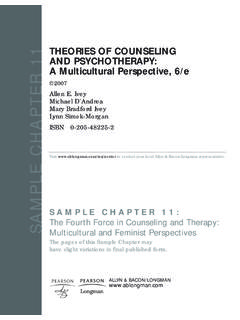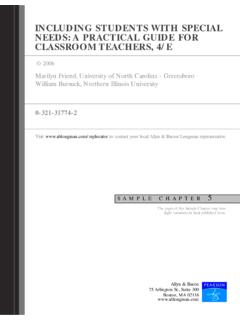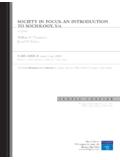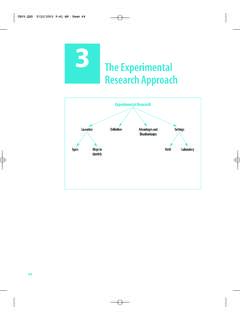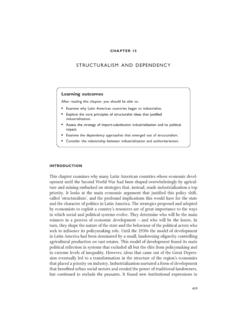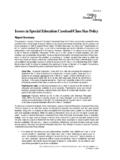Transcription of Literature: An Introduction to Fiction, Poetry, …
1 X. J. KennedyDana GioiaLongman Publishers1185 Avenue of the AmericasNew York, NY ISBN 2007sample chapterThe pages of this Sample Chapter may haveslight variations in final published contact your local Allyn & Bacon/Longman : An Introduction to fiction , poetry , Drama, and Writing, Compact Edition, 5/e743 CharacterShow me a character without anxietiesand I will show you a boring book. MARGARET ATWOODFrom popular fiction and drama, both classic and contemporary, we are acquaintedwith many stereotyped characters. Called stock characters, they are often known bysome outstanding trait or traits: the braggingsoldier of Greek and Roman comedy, thePrince Charmingof fairy tales, the madscientist of horror movies, the fearlessly recklesspolice detective of urban action films, the greedyexplorer of Tarzan films, the brilliantbut alcoholicbrain surgeon of medical thrillers on television. Stock characters are es-pecially convenient for writers of commercial fiction : they require little detailed por-traiture, for we already know them well.
2 Most writers of the literary story, however,attempt to create characters who strike us not as stereotypes but as unique individu-als. Although stock characters tend to have single dominant virtues and vices, char-acters in the finest contemporary short stories tend to have many facets, like peoplewe character, then, is presumably an imagined person who inhabits a story although that simple definition may admit to a few exceptions. In George Stewart snovel Storm,the protagonist is the wind; in Richard Adams s Watership Down,themain characters are rabbits. But usually we recognize, in the main characters of astory, human personalities that become familiar to us. If the story seems true to life, we generally find that its characters act in a reasonably consistent manner and thatthe author has provided them with motivation: sufficient reason to behave as theydo. Should a character behave in a sudden and unexpected way, seeming to denywhat we have been told about his or her nature or personality, we trust that there wasa reason for this behavior and that sooner or later we will discover it.
3 This is not toclaim that allauthors insist that their characters behave with absolute consistency,for (as we shall see later in this chapter) some contemporary stories feature characterswho sometimes act without apparent reason. Nor can we say that, in good Fiction, characters never change or develop. In A Christmas Carol,Charles Dickens tells howEbenezer Scrooge, a tightfisted miser, reforms overnight, suddenly gives to the poor,and endeavors to assist his clerk s struggling family. But Dickens amply demonstrateswhy Scrooge had such a change of heart: four ghostly visitors, stirring kind memoriesthe old miser had forgotten and also warning him of the probable consequences of hishabits, provide the character (and hence the story) with adequate 9/20/06 1:12 PM Page 74 Character75To borrow the useful terms of the English novelist E. M. Forster, characters mayseem flator round, depending on whether a writer sketches or sculpts them.
4 A flatcharacter has only one outstanding trait or feature, or at most a few distinguishingmarks: for example, the familiar stock character of the mad scientist, with his lust forabsolute power and his crazily gleaming eyes. Flat characters, however, need not bestock characters: in all of literature there is probably only one Tiny Tim, though hisfunctions in A Christmas Carolare mainly to invoke blessings and to remind others oftheir Christian duties. Some writers, notably Balzac, who peopled his many novelswith hosts of characters, try to distinguish the flat ones by giving each a single oddphysical feature or mannerism a nervous twitch, a piercing gaze, an obsessive fond-ness for oysters. Round characters, however, present us with more facets that is,their authors portray them in greater depth and in more generous detail. Such around character may appear to us only as he appears to the other characters in thestory.
5 If their views of him differ, we will see him from more than one side. In otherstories, we enter a character s mind and come to know him through his ownthoughts, feelings, and perceptions. By the time we finish reading James Baldwin s Sonny s Blues (in Chapter 2), we are well acquainted with the central charactersand find them amply characters tend to stay the same throughout a story, but round characters of-ten change learn or become enlightened, grow or deteriorate. In William Faulkner s Barn Burning (Chapter 5), the boy Sarty Snopes, driven to defy his proud and vio-lent father, becomes at the story s end more knowing and more mature. (Some criticscall a fixed character static; a changing one, dynamic.) This is not to damn a flat char-acter as an inferior work of art. In most fiction even the greatest minor characterstend to be flat instead of round. Why? Rounding them would cost time and space; andso enlarged, they might only distract us from the main characters.
6 A character, first of all, is the noise of his name, according to novelist , chosen artfully, can indicate natures. A simple illustration is the com-pletely virtuous Squire Allworthy, the foster father in Tom Jonesby Henry , perhaps, is the custom of giving a character a name that makes an allusion: areference to some famous person, place, or thing in history, in other fiction , or in ac-tuality. For his central characters in Moby-Dick,Herman Melville chose names fromthe Old Testament, calling his tragic and domineering Ahab after a biblical tyrantwho came to a bad end, and his wandering narrator Ishmael after a biblical or not it includes an allusion, a good name often reveals the character ofthe character. Charles Dickens, a vigorous and richly suggestive christener, named acharming confidence man Mr. Jingle (suggesting something jingly, light, and superfi-cially pleasant), named a couple of shyster lawyers Dodgson and Fogg (suggestingdodging evasiveness and foglike obfuscation), and named two heartless educators,who grimly drill their schoolchildren in hard facts, Gradgind and M Choakum-child.
7 Henry James, who so loved names that he kept lists of them for characters hemight someday conceive, chose for a sensitive, cultured gentleman the name of Lam-bert Strether; for a down-to-earth, benevolent individual, the name of Mrs. Bread.(But James may have wished to indicate that names cannot be identified with peopleabsolutely, in giving the fragile, considerate heroine of The Spoils of Poyntontheharsh-sounding name of Fleda Vetch.)1 The Concept of Character in fiction , fiction and the Figures of Life(New York: Knopf, 1970). 9/20/06 1:12 PM Page 75 Character76 Instead of a hero, many a recent novel has featured an antihero: a protagonistconspicuously lacking in one or more of the usual attributes of a traditional hero(bravery, skill, idealism, sense of purpose). The antihero is an ordinary, ungloriouscitizen of the modern world, usually drawn (according to Sean O Faolain) as some-one groping, puzzled, cross, mocking, frustrated, and isolated.
8 2(Obviously, thereare antiheroines, too: Ellen, for instance, is the aimlessly drifting central character ofEdna O Brien s novel August Is a Wicked Month.) If epic poets once drew their heroesas decisive leaders of their people, embodying their people s highest ideals, antiheroestend to be loners, without perfections, just barely able to survive. Antiheroes lack character, as defined by psychologist Anthony Quinton to mean a person s conductor persistence and consistency in seeking to realize his long-term aims. 3A gulf sep-arates Leopold Bloom, antihero of James Joyce s novel Ulysses,from the hero of theGreek Homer s epic, Ulysses wanders the Mediterranean, battling mon-sters and overcoming enchantments. In Joyce s novel, Bloom wanders the litteredstreets of Dublin, peddling advertising space. Meursault, the title character of AlbertCamus s novel The Stranger,is so alienated from his own life that he is unmoved atthe news of his mother s , not only fashions in heroes but also attitudes toward human naturehave undergone change.
9 In the eighteenth century, Scottish philosopher David Humeargued that the nature of an individual is relatively fixed and unalterable. Hume men-tioned, however, a few exceptions: A person of an obliging disposition gives a peev-ish answer; but he has the toothache or has not dined. A stupid fellow discovers anobvious alacrity in his carriage; but he has met with a sudden piece of good fortune. For a long time after Hume, novelists and short-story writers seem to have assumedthat characters nearly always behave in a predictable fashion and that their actionsought to be consistent with their personalities. Now and again, a writer differed: JaneAusten in Pride and Prejudicehas her protagonist Elizabeth Bennet remark to the citi-fied Mr. Darcy, who fears that life in the country cannot be amusing, But peoplethemselves alter so much, that there is something to be observed in them forever. Many contemporary writers of fiction would deny even that people have definiteselves to alter.
10 Following Sigmund Freud and other modern psychologists, they assume that a large part of human behavior is shaped in the unconscious that, forinstance, a person might fear horses, not because of a basically timid nature, but because of unconscious memories of having been nearly trampled by a horse when achild. To some writers it now appears that what Hume called a disposition (whatwe call a personality ) is more vulnerable to change from such causes as age, disease,neurosis, psychic shock, or brainwashing than was once believed. Hence, some char-acters in modern fiction appear to be shifting bundles of impulses. You mustn t lookin my novel for the old stable ego of character, wrote D. H. Lawrence to a friendabout The Rainbow;and in that novel and others Lawrence demonstrated his view ofindividuals as bits of one vast Life Force, spurred to act by incomprehensible passionsand urges the dark gods in them. The idea of the gratuitous act, a deed withoutcause or motive, is explored in Andr Gide s novel Lafcadio s Adventures,in whichan ordinary young man without homicidal tendencies abruptly and for no reasonpushes a stranger from a speeding train.


